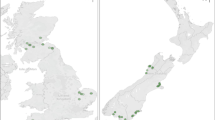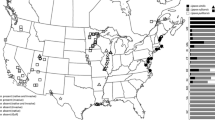Abstract
The Enemy Release (ER) hypothesis predicts an increase in the plant invasive capacity after being released from their associated herbivores or pathogens in their area of origin. Despite the large number of studies on biological invasions addressing this hypothesis, tests evaluating changes in herbivory on native and introduced populations and their effects on plant reproductive potential at a biogeographical level are relatively rare. Here, we tested the ER hypothesis on the South African species Senecio pterophorus (Asteraceae), which is native to the Eastern Cape, has expanded into the Western Cape, and was introduced into Australia (>70–100 years ago) and Europe (>30 years ago). Insect seed predation was evaluated to determine whether plants in the introduced areas were released from herbivores compared to plants from the native range. In South Africa, 25 % of the seedheads of sampled plants were damaged. Plants from the introduced populations suffered lower seed predation compared to those from the native populations, as expected under the ER hypothesis, and this release was more pronounced in the region with the most recent introduction (Europe 0.2 % vs. Australia 15 %). The insect communities feeding on S. pterophorus in Australia and Europe differed from those found in South Africa, suggesting that the plants were released from their associated fauna after invasion and later established new associations with local herbivore communities in the novel habitats. Our study is the first to provide strong evidence of enemy release in a biogeographical survey across the entire known distribution of a species.



Similar content being viewed by others
References
Adams JM, Fang W, Callaway RM, Cipollini D, Newell E (2009) A cross-continental test of the Enemy Release Hypothesis: leaf herbivory on Acer platanoides (L.) is three times lower in North America than in its native Europe. Biol Invasions 11:1005–1016. doi:10.1007/s10530-008-9312-4
Agosta SJ (2006) On ecological fitting, plant-insect associations, herbivore host shifts, and host plant selection. Oikos 114:556–565. doi:10.1111j.2006.0030-1299.15025.x
Agrawal AA, Kotanen PM (2003) Herbivores and the success of exotic plants: a phylogenetically controlled experiment. Ecol Lett 6:712–715. doi:10.1046/j.1461-0248.2003.00498.x
Barberis G, Minuto L, Peccenini S (1998) Senecio grisebachii Baker (Compositae), new to the Italian flora. Webbia 52:201–206
Brändle M, Kuhn I, Klotz S, Belle C, Brandl R (2008) Species richness of herbivores on exotic host plants increases with time since introduction of the host. Divers Distrib 14:905–912. doi:10.1111/j.1472-4642.2008.00511.x
Caño L, Escarré J, Fleck I, Blanco-Moreno JM, Sans FX (2008) Increased fitness and plasticity of an invasive species in its introduced range: a study using Senecio pterophorus. J Ecol 96:468–476. doi:10.1007s00442-008-1182-z
Casasayas T (1989) La flora al lòctona de Catalunya. Catàleg raonat de les plantes vasculars exòtiques que creixen sense cultiu al NE de la Península Ibèrica. Dissertation, Universitat de Barcelona, Barcelona
Castells E, Berhow MA, Vaughn SF, Berenbaum MR (2005) Geographic variation in alkaloid production in Conium maculatum populations experiencing differential herbivory by Agonopterix alstroemeriana. J Chem Ecol 31:1693–1709. doi:10.1007/s10886-005-5921-x
Chamorro L, Caballero B, Blanco-Moreno JM, Caño L, Garcia-Serrano H, Masalles RM, Sans FX (2006) Ecología y distribución de Senecio pterophorus (Compositae) en la Península Ibérica. An Jard Bot Madr 53:55–62. doi:10.3989/ajbm.2006.v63.i1.31
Colautti RI, Ricciardi A, Grigorovich IA, MacIsaac HJ (2004) Is invasion success explained by the enemy release hypothesis? Ecol Lett 7:721–733. doi:10.1111/j.1461-0248.2004.00616.x
Cripps MG, Schwarzlander M, McKenney JL, Hinz HL, Price WJ (2006) Biogeographical comparison of the arthropod herbivore communities associated with Lepidium draba in its native, expanded and introduced ranges. J Biogeogr 33:2107–2119. doi:10.1111/j.1365-2699.2006.01560.x
Cripps MG, Edwards GR, Bourdôt GW, Saville DJ, Hinz HL, Fowler SV (2010) Enemy release does not increase performance of Cirsium arvense in New Zealand. Plant Ecol 209:123–134
DeWalt SJ, Denslow JS, Ickes K (2004) Natural-enemy releases facilitates habitat expansion of the invasive thropical shrub Clidemia hirta. Ecology 85:471–483
Dirección General de Aduanas de España (1951–1986) Estadística del comercio exterior de España. Ministerio de Hacienda, Madrid
Ebeling SK, Hensen I, Auge H (2008) The invasive shrub Buddleja davidii performs better in its introduced range. Divers Distrib 14:225–233. doi:10.1111/j.1472-4642.2007.00422.x
Elton CS (1958) The Ecology of Invasions by animals and plants. Methuen, London
Engelkes T, Morrien E, Verhoeven KJF, Bezemer TM, Biere A, Harvey JA, McIntyre LM, Tamis WLM, van der Putten WH (2008) Successful range-expanding plants experience less above-ground and below-ground enemy impact. Nature 456:946–948. doi:10.1038/nature07474
Fenner M, Lee WG (2001) Lack of pre-dispersal seed predators in introduced Asteraceae in New Zealand. NZ J Ecol 25:95–99
Font X (2012) Vegetation and flora module. Biodiversity database of Catalonia. <http://biodiver.bio.ub.es/biocat/homepage.html>. Accessed 28 November 2012
Graves SD, Shapiro AM (2003) Exotics as host plants of the California butterfly fauna. Biol Conserv 110:413–433 pii: S0006-3207(02)00233-1
Gurevitch J, Fox GA, Wardle GM, Inderjit, Taub D (2011) Emergent insights from the synthesis of conceptual frameworks for biological invasions. Ecol Lett 14:407–418. doi:10.1111/j.1461-0248.2011.01594.x
Hall DB (2000) Zero-inflated Poisson and binomial regression with random effects: a case study. Biometrics 56:1030–1039. doi:10.1111j.0006-341X.2000.01030.x
Hardy DE, Drew RAI (1996) Revision of the Australian Tephritini (Diptera: Tephritidae). Invertebr Taxon 10:213–405. doi:10.1071/IT9960213
Hawkes CV (2007) Are invaders moving targets? The generality and persistence of advantages in size, reproduction, and enemy release in invasive plant species with time since introduction. Am Nat 170:832–843. doi:10.1086/522842
Hierro JL, Maron JL, Callaway RM (2005) A biogeographical approach to plant invasions: the importance of studying exotics in their introduced and native range. J Ecol 93:5–15. doi:10.1111/j.1365-2745.2004.00953.x
Hijmans RJ, Cameron SE, Parra JL, Jones PG, Jarvis A (2005) Very high resolution interpolated climate surfaces for global land areas. Int J Climatol 25:1965–1978. doi:10.1002/joc.1276
Hilliard OM (1977) Compositae in natal. University of Natal Press, Pietermaritzburg
Hinz HL, Schwarzlander M, McKenney JL, Cripps MG, Harmon B, Price WJ (2012) Biogeographical comparison of the invasive Lepidium draba in its native, expanded and introduced ranges. Biol Invasions 14:1999–2016
Keane RM, Crawley MJ (2002) Exotic plant invasions and the enemy release hypothesis. Trends Ecol Evol 17:164–170 pii: S0169-5347(01)02430-2
Kolb A, Ehrlén J, Eriksson O (2007) Ecological and evolutionary consequences of spatial and temporal variation in pre-dispersal seed predation. Perspect Plant Ecol 9:79–100. doi:10.1016/j.ppees.2007.09.001
Levyns MR (1950) Compositae. In: Adamson RS, Salter TM (eds) Flora of the cape peninsula. Juta, Cape Town
Maron JL, Vilà M (2001) When do herbivores affect plant invasion? Evidence for the natural enemies and biotic resistance hypotheses. Oikos 95:361–373. doi:10.1034/j.1600-0706.2001.950301.x
Maron JL, Vilà M, Bommarco R, Elmendorf S, Beardsley P (2004) Rapid evolution of an invasive plant. Ecol Monogr 74:261–280
McCullagh P, Nelder JA (1989) Generalized linear models. Chapman & Hall, London
Memmott J, Fowler SV, Paynter Q, Sheppard AW, Syrett P (2000) The invertebrate fauna on broom, Cytisus scoparius, in two native and two exotic habitats. Acta Oecol 21:213–222
Mitchell CE, Blumenthal D, Jarosik V, Puckett EE, Pysek P (2010) Controls on pathogen species richness in plants’ introduced and native ranges: roles of residence time, range size and host traits. Ecol Lett 13:1525–1535. doi:10.1111/j.1461-0248.2010.01543.x
Parker JD, Hay ME (2005) Biotic resistance to plant invasions? Native herbivores prefer non-native plants. Ecol Lett 8:959–967. doi:10.1111j.1461-0248.2005.00799.x
Parsons WT, Cuthbertson EG (1992) Noxious weeds of Australia. Inkata, Melbourne
Pimentel D, Lach L, Zuniga R, Morrison D (2000) Environmental and economic costs of nonindigenous species in United States. Bioscience 50:53–65
Prati D, Bossdorf O (2004) A comparison of native and introduced populations of the South African Ragwort Senecio inaequidens DC. in the field. In: Breckle SW, Schweizer B, Fandmeier A (eds) Results of the worldwide ecological studies. Heimbach, Stuttgart, pp 353–359
Preston CA, Pearman DA, Dines TD (2002) New altlas of the British and Irish flora: an atlas of the vacular plants of Britain, Ireland, the Isle of Man and the Channel Islands. Oxford University Press, Oxford
Richards CL, Bossdorf O, Muth NZ, Gurevitch J, Pigliucci M (2006) Jack of all trades, master of some? On the role of phenotypic plasticity in plant invasions. Ecol Lett 9:981–993. doi:10.1111/j.1461-0248.2006.00950.x
Roesler U (1973) Phycitinae. 1. Teilband: Trifine Acrobasina. In: Amsel HG, Gregor F, Reisser H (eds) Microlepidoptera Palaearctica. Fromme, Wien
Sans FX, Garcia-Serrano H, Afán I (2004) Life-history traits of alien and native Senecio species in the Mediterranean region. Acta Oecol 26:167–178. doi:10.1016/j.actao.2004.04.001
Schaffner U, Ridenour WM, Wolf VC, Basset T, Müller C, Müller-Scharer H, Sutherland S, Lortie JL, Callaway RM (2011) Plant invasions, generalist herbivores, and novel defense weapons. Ecology 92:829–835
Sheppard AW, Brun LA, Lewis RC (1996) A demographic comparison of common heliotrope. Heliotropium europaeum L.: Southern Australia and Southern France. In: Shepherd RCH (ed) Eleventh Australian Weeds Conference Proceedings. Weed Science Society of Victoria, Victoria, pp 286–290
Siemann E, Rogers WE, DeWalt SJ (2006) Rapid adaptation of insect herbivores to an invasive plant. Proc R Soc Lond B 273:2763–2769. doi:10.1098/rspb.2006.3644
Tallamy DW, Ballard M, D’Amico V (2010) Can alien plants support generalist insect herbivores? Biol Invasions 12:2285–2292. doi:10.1007s10530-009-9639-5
The Council of Heads of Australasian Herbaria (1999–2012). Australia’s virtual herbarium. <www.chah.gov.au/avh> Accessed 28 November 2012
Thompson JN (1994) The coevolutionary process. University of Chicago Press, Chicago
Verhoeven KJF, Biere A, Harvey JA, van der Putten WH (2009) Plant invaders and their novel natural enemies: who is naive? Ecol Lett 12:107–117. doi:10.1111/j.1461-0248.2008.01248.x
Vilà M, Maron JL, Marco L (2005) Evidence for the enemy release hypothesis in Hypericum perforatum. Oecologia 142:474–479. doi:10.1007s00442-004-1731-z
Vitousek PM, D’Antonio CM, Loope LL, Westbrooks R (1996) Biological invasions as global environmental change. Am Sci 84:468–478
Williams JL, Auge H, Maron JL (2010) Testing hypotheses for exotic plant success: parallel experiments in the native and introduced ranges. Ecology 91:1355–1366
Wolfe LM (2002) Why alien invaders succeed: support for the escape-from-enemy hypothesis. Am Nat 160:705–711. doi:10.1086/343872
Zangerl AR, Stanley MC, Berenbaum MR (2008) Selection for chemical trait remixing in an invasive weed after reassociation with a coevolved specialist. Proc Natl Acad Sci USA 105:4547–4552. doi:10.1073/pnas.0710280105
Acknowledgments
We thank the collaborators for providing data and helping during the collecting trips: Dr Jaco Le Roux (Stellenbosch University, South Africa), Christina Potgieter (University of KwaZulu-Natal, South Africa), Dr. Ian Thompson (Royal Botanic Gardens, Melbourne, Australia), Tony Dold (Rhodes University, South Africa), and David Wopula (South Africa). We thank Anna Escolà and Pere Losada for outstanding field and laboratory assistance, Estíbaliz Palma for seed analyses, and Bernhard Merz (Muséum d’Histoire Naturelle, Switzerland) and Jordi Dantart (Catalonia) for identification of insect specimens. M.M. has a FPI predoctoral fellowship from Ministerio de Ciencia e Innovación (Spain). This research was conducted thanks to the financial support provided to E.C. by Ministerio de Ciencia e Innovación (Spain) (GCL2008-02421/BOS) and Ministerio de Economía y Competitividad (Spain) (GCL2011-29205). X.S., E.C., J.M.B.M. and M.M. belong to the Agroecosystems Research group funded by Generalitat de Catalunya (Catalonia) (2009 SGR1058). The experiments comply with the current laws of the countries (Spain, Italy, Australia, and South Africa) in which the experiments were performed. The permits required for sampling were obtained from the corresponding authorities when necessary.
Author information
Authors and Affiliations
Corresponding author
Additional information
Communicated by John Lill.
Rights and permissions
About this article
Cite this article
Castells, E., Morante, M., Blanco-Moreno, J.M. et al. Reduced seed predation after invasion supports enemy release in a broad biogeographical survey. Oecologia 173, 1397–1409 (2013). https://doi.org/10.1007/s00442-013-2718-4
Received:
Accepted:
Published:
Issue Date:
DOI: https://doi.org/10.1007/s00442-013-2718-4




